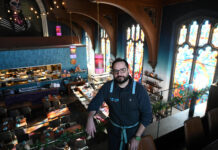Objectivity is a key element of journalism, which in our contemporary era has been supplanted in large measure by advertising-supported electronic hype machines.
Taking sports as an example, media coverage in the current era has tended to devolve to mere carnival barking.
In consequence, a talented big league baseball player with two or three good seasons under his belt according to the statistical standards of modern analytics, which as an aside, and while objective in the sense of remorseless mathematics, have made the game almost unwatchable because the human element has been savagely suppressed, is certain to be presumptively tagged by media outlets as a “future Hall of Famer,” or variously, in an even more annoying manifestation of short attention spans, as the GOAT (“greatest of all time”).
The click bait duly dangled, cyber flame battles commence. None of them contributes a jot to a greater understanding of baseball or any other relevant issue, although the thrill of vanquishing opponents on the Interwebz suffices as an updated variation of gladiatorial combat in ancient Rome, albeit it a form of mayhem pursued with mobile devices from the comfort of one’s upholstered armchair while pretending to “work” at home.
(As an aside, if the very same HoF-bound player has a single bad year, he’s forgotten, and likely never played baseball in the first place. The hype machine requires 24-7-365 feeding, and someone else easily becomes the new GOAT, thus sparing us, if only for another few milliseconds, the sheer horror of examining evidence for ourselves.)
America remains a place where pertinent criteria crawl off to die slow and painful deaths, but I remain undeterred. At the risk of offending the (dubious) mechanics of tilt-a-whirl electronic kaleidoscopes, allow me to suggest that it isn’t really possible to have the perspective necessary to form truly objective judgements without possessing a longer view, which in turn often is assisted by the simple act of ongoing chronology.
In short, one must allow a bit of time to pass.
As the eminent musical philosopher W. Axl Rose once wisely counseled, “All we need is just a little patience,” or an attention span sufficient to consider this brief history of Louisville brewing in five handy eras.
The Old World, 1778 – 1920
Louisville’s first brewers were from the British Isles; one of them, Hew Ainslie, was a political refugee and Scots nationalist poet. From the late 1840s, when the Germans came to America and brought with them knowledge of the nascent lager brewing revolution, Pilsner supplanted Porter, and pale golden would remain unchallenged for more than a century.
Prohibition, 1920 – 1933
The “noble experiment” was an unmitigated cultural disaster, one suffered primarily by immigrants and the poor, while being handily evaded by those of sufficient wealth and status. Hundreds of breweries disappeared forever, but the methodology of top-heavy enforcement lived on, to be revived during a later “War on Drugs.”
Restoration and Dissolution, 1933 – 1990
A handful of Louisville breweries returned after Prohibition, most prominently Fehr’s, Oertel’s and Falls City, but by 1978 they’d all been swept away by the mores of postwar social conformity and multinational brewing consolidation. During the 1970s, industry experts predicted that in 20 years there’d be only two or three very large breweries left standing in the entire country, but in California in 1976, New Albion became the first brewery start-up since Prohibition. A trend was afoot, eventually to reach Louisville in 1990.
A Whole New Ballgame, 1990 – 2011
Brewing returned to the 502 in 1990 (Charlie’s), 1992 (The Silo) and 1993 (Bluegrass Brewing Company). The first two expired, BBC flourished, and by 2011 there were six breweries. They formed a perimeter of choice, along with a handful of dedicated beer bars, like Rich O’s Public House in New Albany.
Multiplying Like the Proverbial Rabbits, 2011 – 2022
Whether the advent of Against the Grain’s original brewery and restaurant at Louisville Slugger Field (2011) constituted causation or correlation, craft brewing exploded in Louisville shortly thereafter. The timing was perfect in any event. The number of breweries in Louisville has quintupled in 11 years, with still more start-ups being planned.
In the forthcoming Fall 2022 issue of Food & Dining Magazine I’ll be attempting a survey of this beery proliferation. In the interim, here’s this week’s challenging mental exercise.
Using the above eras as a rough framework, what would a list of Louisville’s metro area Hall of Fame beers look like?
Dare I suggest that some might even be classified as GOATs, whether Bock-style ruminants or not?
Two hundred years is a daunting time frame, so after almost five minutes of careful thought over my morning kippers and espresso, I’ve decided to arbitrarily narrow the scope of the present exercise to the period 1990 – 2012.
As a disclaimer, on the order of pre-1900 players in baseball’s HoF, I fully understand that Louisville-brewed beers prior to 1990 belong on this list, but why not begin with the era of my own greatest familiarity?
Ultimately we might accept as default selections the flagship lagers of post-Prohibition Louisville breweries (Fehr’s, Oertel’s, Falls City), then sort through pre-Prohibition history in search of other famous names, perhaps something from the Phoenix brewery (Ungespundet Velodrome Lager, perhaps), or whichever Hibernian styles that Hew Ainslie brewed in New Albany prior to the Civil War.
Next year perhaps there’ll be an Oldtimers Committee, and as the decade’s eligibility requirement provides new candidate breweries each year, they’ll be reviewed (in 2023, breweries starting in 2013—and so on). That’s because returning to the aforementioned notions of patience and perspective, I take the position that at least a decade is required to judge the output of breweries.
Should Mile Wide’s quartet of Boston-themed New England IPAs (NOMAH!, Tessie, Tuck Rule and Moxie) be included herein? Maybe, but yearly future updates will afford the opportunity for expansion.
Finally, I’m the first to concede that the present exercise is contradictory and in the end, purely arbitrary. I offer it with a wink and a nod, in the hope of inspiring discussion.
First, the most obscure selection of all.
Charlie’s: Cream Ale
Charlie’s used to be a restaurant in downtown Louisville, located across Main Street from the Kentucky Center for the Arts at 530 W. Main Street (arguably best known as Los Aztecas Mexican Grill). Around 1989 or 1990, Charlie’s commissioned then-homebrewer David Pierce to brew a house beer. The requisite licensing was procured, and Pierce brewed a Sierra Nevada Pale Ale clone. The experiment didn’t last long, but as the first Louisville “microbrew” of the modern era, surely Charlie’s Cream Ale belongs here.
The Silo Microbrewery: Yuletide Ale
Here’s a Great American Beer Festival medal list that you’ve probably forgotten.
GABF Herb, Spice 1993
GOLD: Celis White–Celis Brewery, Inc., Austin, TX
SILVER: Yuletide Ale–Silo Brewpub, Louisville, KY
BRONZE: Our Special Ale–Anchor Brewing Co., San Francisco, CA.
That’s right, The Silo Microbrewery won Louisville’s first GABF medal for Yuletide Ale in 1993, as sandwiched between two very heavy hitters. Eileen Martin was Silo’s brewer of record in 1993, but the GABF submission came from Pierce’s batch the previous year. He took the idea with him to Bluegrass Brewing Company in 1993, where it formed the basis of BBC’s annual holiday seasonal, Ebenezer Ale.
Bluegrass Brewing Company (BBC): Bearded Pat’s Barley Wine and Dark Star Porter
BBC will turn 30 in 2023, albeit at 3rd and Main across from the Yum! Center, and not in its original, late and lamented St. Matthews location. It remains that any indie business lasting three decades merits recognition, and so many different beers have been brewed at BBC that an entire book could be written. Bearded Pat’s Barley Wine, brewed by David Pierce and named not for owner Hagan but bartender Allgeier (R.I.P.), won two Great American Beer Festival gold medals during the 1990s, and Pierce’s Dark Star Porter was Louisville’s go-to dark “microbrew” at a time when Porters and Stouts (other than Guinness) weren’t always easy to find.
INTERJECTION: Pierce’s name keeps popping up, and for good reason. By 1993 he had mashed in at all three of Louisville’s new-age brewing operations. That’s some pedigree.
Pipkin Brewing Company: Bourbon Barrel Stout
Pipkin (1997-2000), a production facility without a taproom, pioneered the concept of the “Beer Corner of Clay & Main,” later to become BBC’s production brewery, and later still Goodwood Brewing. Pipkin’s primary brands (Pale, Brown) are long forgotten, and not undeservedly so, but Pipkin was the first Louisville brewery to package a Bourbon Barrel Stout (as was customary, Pierce had done it first, although his was draft only). It was fantastic. Louisville brewing history might be very different had Pipkin decided to make this ale its flagship.
Cumberland Brews: Matt’s Red and Nitro Porter
Operating from 2000 through 2019, in the Bardstown Road building where AtG’s Public House has succeeded it, Cumberland Brews was tiny and mighty. The wings were jerk, not buffalo, and one of the most reliable ales to accompany them was Matt’s Red, later referred to as Cumberland Red, which in 2022 is being brewed again by Hometown Brewery on Cumberland’s former production brewing system. Matt’s Red had been formulated at BBC by then-assistant brewer Matt “Brew Boy” Gould (R.I.P.) as Matt’s Amber. I think Matt’s Nitro Porter also deserves selection; however, I’ll entertain other choices. Readers?
Browning’s Brewery: Oatmeal Stout and She-Devil IPA
Martin opened Browning’s Brewery (2002-2008, 2009-2011) in Louisville Slugger Field, which was built from scratch alongside Wellinghurst’s Steak House and included a jaw-dropping three-story tower brewing system. Her founding lineup of beers—Blonde Ale, Cream Ale, Red Ale and ESB—was solid top to bottom, and my favorite was a silky Oatmeal Stout. Following Martin’s unfortunate ouster amid a troubled interregnum of ownership changes, Brian Reymiller was hired. His tenure is remembered for She-Devil IPA, variously described as an “Imperial” Pale Ale or a Double IPA, and presumably inspired by Victory Brewing’s Hop Devil Pale Ale, Reymiller having worked there before coming to Louisville.
New Albanian Brewing Company (NABC): Community Dark and Elector
Full disclosure: NABC is your friendly correspondent’s former business. In 2002, the first commercial beer to be brewed in New Albany since 1937 was Community Dark, an English Mild Ale and the ideal complement to pizza. It’s usually been NABC’s top seller in-house ever since. Brewer Michael Borcher’s first seasonal a few months later was intended to be a Winter Warmer along the lines of Samuel Smith’s. It turned out very different: amber red (not brown), hop-forward, and to this very day a serendipitous accident without a specific style category. Dubbed Elector Ale because it was brewed two years to the day from the 2000 presidential election, it spawned a slogan: “An Elector makes democracy pointless.”
Falls City Brewing Company: Pale Ale and Kentucky Common
David Easterling, who revived Falls City as a going concern in 2010 and later sold the company to the current owners, likely will be only a footnote to modern Louisville brewing history. However, Easterling deserves credit for one huge insight, because when he chose to contract-brew a flagship beer and revive the Falls City brand, the result was a starter-level English-style Pale Ale, not a golden lager that probably would have been confused with previous iterations perceived by the public as inferior. More recently, Falls City has persisted with a fine reboot of Kentucky Common, which might be the single most underappreciated beer in town today.
Against the Grain Brewery: Bo and Luke and Citra Ass Down
What is there to say about Against the Grain that hasn’t already been said, loudly and incessantly, with requisite skid marks, by AtG itself? I’m obliged to remind younger readers that AtG’s advent in 2011 came with a promise of permanent revolution in the sense of a vow never to brew the same batch twice, perhaps still the case within the confines of the original Slugger Field brewhouse. Bo and Luke, a smoked imperial stout, is an annual special release, while Citra Ass Down is an “everyday” Double India Pale Ale.
Apocalypse Brew Works: Atomic Amber and Fallout Dust
In 2012 legendary homebrewer Leah Dienes joined with friends Bill and Jane Krauth to install a small brewery in Bill’s family-run heating and air building on Mellwood Avenue. The Fallout Shelter taproom is indeed intimate, but this is a beer venue irresistible for its outdoor, dog-friendly expanse, which often hosts food trucks. Atomic Amber (is there any more unfairly neglected craft style than Amber Ale?) and Fallout Dust (a pepper-infused blonde) are enduring favorites.
Gordon Biersch: Märzen
Louisville’s branch of the national brewpub chain, situated at the northern terminus of the 4th Street Live entertainment district, opened in 2012. It survived the pandemic, and yet in beer terms, Biersch seems perpetually ignored. Long-term yeast wrangler Nicholas Landers has been brewing Biersch’s beers on site in Louisville for most (maybe all?) of the brewpub’s existence, and the classic core of German beer styles, including the wonderful year-round Märzen, has been augmented in recent years by IPAs, Belgian Ales and Stouts. Does a second Biersch bier belong on this list? Let me know.
That’s it. What do you think? What did I miss? There’ll surely be updates. As a closing thought, I’m looking over a stylistically varied list of beers, but three very popular letters of the brewing alphabet are not well represented: I, P and A.
That’s because until recently, say 10-15 years ago, IPA wasn’t a tail that typically wagged beer-loving dogs (or humans). Times change, and it’s a Louisville Beer Hall of Fame balance of power quite likely to shift in the coming years.
Cover photo: Brewster Eileen Martin and beer writer Michael Jackson at The Silo Microbrewery, 1994.




















 Roger Baylor is an educator, entrepreneur and innovator with 40 years of hands-on experience and expertise as a beer seller, restaurateur and commentator. As the co-founder of New Albany’s Sportstime Pizza/Rich O’s Public House (which later became New Albanian Brewing Company) in the 1990s and early 2000s, Baylor played a seminal role in Louisville’s craft beer renaissance. Currently he is the beer director at Pints&union in New Albany and Common Haus Hall in Jeffersonville. Baylor’s “Hip Hops” columns on beer-related subjects have been a fixture in F&D since 2005, and he was named the magazine’s digital editor in 2019.
Roger Baylor is an educator, entrepreneur and innovator with 40 years of hands-on experience and expertise as a beer seller, restaurateur and commentator. As the co-founder of New Albany’s Sportstime Pizza/Rich O’s Public House (which later became New Albanian Brewing Company) in the 1990s and early 2000s, Baylor played a seminal role in Louisville’s craft beer renaissance. Currently he is the beer director at Pints&union in New Albany and Common Haus Hall in Jeffersonville. Baylor’s “Hip Hops” columns on beer-related subjects have been a fixture in F&D since 2005, and he was named the magazine’s digital editor in 2019.





